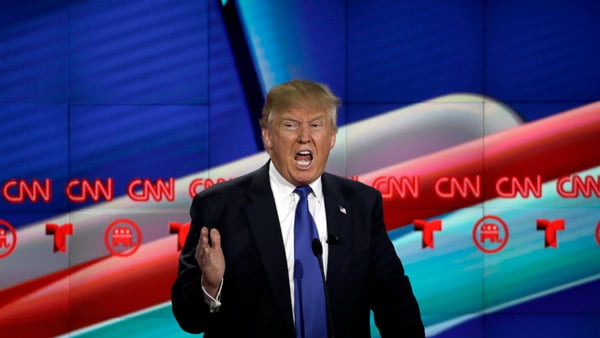 (Photo: AP)
(Photo: AP)
The biggest risk to longest running U.S. economic expansion, now in its eleventh year, is none other than the man in the White House, according to Mark Zandi, chief economist at Moody’s Analytics.
“President Trump is the biggest existential threat to the record U.S. economic expansion,” Zandi told BenefitsPRO’s sister site, ThinkAdvisor.
His “upside-down economic policies,” including a trade war with China, which Trump says will expand on Sept. 1, and “massive deficit-financed tax cuts” at a time when unemployment was already very low have unnerved businesses and “thrown the Federal Reserve off course,” according to Zandi.
Fed Chairman Jerome Powell admitted as much in the press conference last Wednesday following the Fed’s first rate cut since the financial crisis.
“Trade is unusual,” said Powell in response to a reporter’s question. “It’s something that we haven’t faced before and that we’re learning by doing … with trade we have to react to the developments, and we don’t know what they’ll be.”
A day later Trump announced plans to slap an additional 10% tariffs on $300 billion of Chinese imports on top of the 25% tariffs already levied on $250 billion worth of Chinese imports. If Trump sticks with his latest plan, essentially all Chinese imports into the U.S. will be subject to a tariff.
The Chinese government, which has already levied tariffs on about $110 billion in imports from the U.S., vowed to respond to the new levies but gave no specifics.
Trump has also renewed threats to impose U.S. tariffs on European auto imports.
Trade tensions “do seem to be having a significant effect on financial market conditions and on the economy,” said Powell at his press conference, noting that trade uncertainty, slowing global growth and muted inflation below the Fed’s 2% target were the reasons behind the Fed rate cut. He called the rate cut a “mid-cycle adjustment” and “not the start of a series of rate cuts.”
But by Friday the financial markets weren’t buying that outlook, according to Collin Martin, director of fixed income at the Schwab Center for Financial Research.
“An additional round of tariffs could potentially slow the U.S. growth even more than expected,” leading to additional Fed rate cuts, Collins explains.
By the close of trading on Friday, the S&P 500 was down 3.1% for the week, posting its worst performance since December, and the 10-year U.S. Treasury note fell to 1.864%, its lowest level since the day before the 2016 presidential election.
Fed fund futures were pricing in 97% odds of another 25-basis-point Fed rate cut in September and roughly 50% odds of another same-sized cut in October or December, according to the CME FedWatch Tool.
“The Fed won’t tolerate an economic slowdown while President Trump is determined to “win” the trade war,” wrote Bank of America Securities Economists Michelle Meyer and Alexander Lin, in their latest weekly report. “The risk is that we end up with an ever-escalating trade war matched by an ever-lower fed funds rate. It is a dangerous adverse feedback loop.”
And it may not even help the economy.
“Reducing rates now, which are already so low, won’t do much good,” says Gary Shilling, founder of the investment advisory firm A. Gary Shilling & Co., who believes the U.S. economy is already in recession. “
There’s too much credit in the system now … Lowering rates, with a zero bound Fed policy, will not encourage borrowing and spending, but saving.”
The U.S. savings rate reached 8.1% in June, its highest level since December 2012, according to the Federal Reserve Bank of St. Louis.
David Kotok, chairman and chief investment officer of Cumberland Advisors, agrees with Shilling. “When you lower rates you get a capital markets kick one time and we got it, it’s over. Then you have to live with reduced income flows and that’s where we are.”
“Investors ought to stop focusing on what the Fed does and more on why the Fed is easing policy, which is the softness of the economy,” says Shilling.
And Trump’s latest escalation of the trade war could intensify the slowdown.
BofA Securities’ Meyer and Lin warn that “all tariff options — 25% tariffs on China, autos, and Vietnam — are on the table.”
U.S. businesses are already feeling the impact of the U.S.-China trade war, refraining from making big investments despite last year’s big corporate tax cut, and slowing hiring, according to Zandi.
U.S. consumers have also been hurt. A New York Fed report found that the 10% tariffs on $200 billion worth of Chinese exports — which were increased to 25% in May — cost the typical household $419 per year and that will only grow if the tariffs do.
About 40% of all the clothes sold in the United States are made in China, as are about 70% and 90% of the shoes and toys.
“What I fear now is a move by Trump to put currency exchange into this fight, and the Chinese worry about that too,” says Kotok. If the Chinese permit the yuan to weaken further above seven yuan to one U.S. dollar that would suggest they are ready for a “full-blown trade war and there will be no negotiation,” says Kotok. “At 7.15 the U.S. will call China a currency manipulator, which would invoke different U.S. laws.”
In trading Monday morning the yuan breached the 7-per-dollar level.
In the meantime the Fed is “working hard to offset the fallout from the president’s capricious trade decisions” and Trump’s constant criticism of the Fed and Twitter attacks on Powell for not lowering rates more aggressively, Zandi wrote in a recent opinion piece on CNN.com. He tells ThinkAdvisor that “monetary policy is working,” but whether it can “save the day depends on the president … I don’t see this ending gracefully.”
Beth Ann Bovino, chief U.S. economist at S&P Global Ratings, has “full faith” that the Fed is not being influenced by the White House, but she notes that the administration’s negative comments toward the central bank and its chairman “feed into the markets, which impacts market sentiment on where the expansion is going. Does the market lose faith in the Fed? It’s a concern.”
READ MORE:
6 economic predictions for the next 5 years
© 2025 ALM Global, LLC, All Rights Reserved. Request academic re-use from www.copyright.com. All other uses, submit a request to [email protected]. For more information visit Asset & Logo Licensing.








